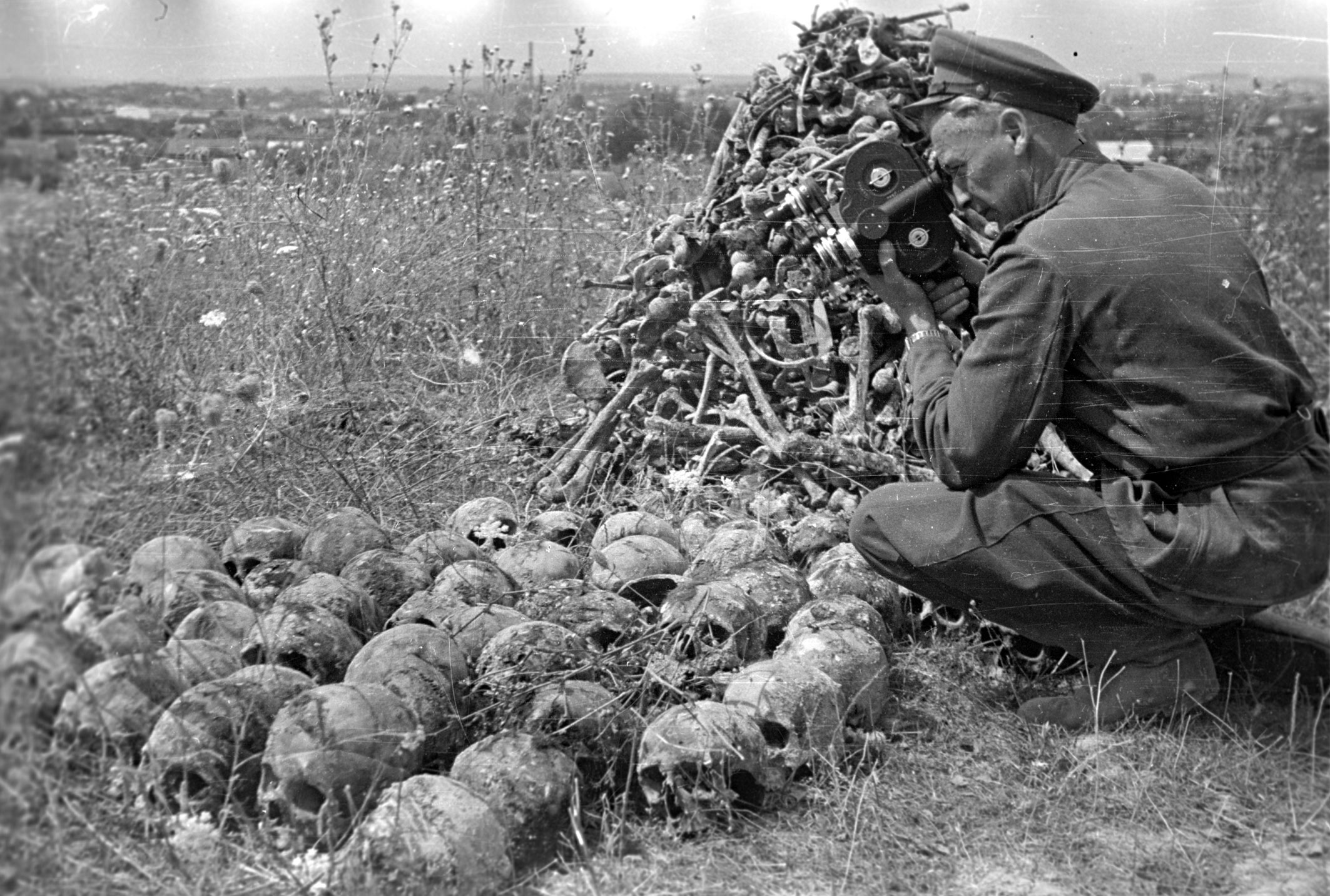It was a photograph “smuggled out of Poland” which in January 1944 pushed Arthur Koestler to “scream”. As a writer he chose the form of an essay which appeared in the New York Times Magazine under the title “The Nightmare That Is a Reality”. He reminded English-speaking readers of the ongoing “greatest mass-killing in recorded history”, complaining about the indifference of the average Western citizen who cares more about a “dog run over by a car” than “three million Jews killed in Poland”. Clearly, a different kind of proof was necessary, in a medium which would surpass word and static image.
Six months later, the Red Army was advancing through Eastern Poland when they discovered the first traces of “Operation Reinhardt”, the code name for the murder of the Jews in Poland. On reaching Lublin they found an enormous compound behind barbed wire in the city’s suburb of Majdanek. Embedded with the Soviet army were film crews, who subsequently made the first images of a Nazi camp with extermination facilities. One would think that at this point a new type of proof in the form of a moving image with sound would show to the world that the camps were real. However, for many months not one single film shot from this “death factory”, as it was called by Soviet journalists in August 1944, became available.
The late appearance of the Majdanek film material, 16 weeks after the liberation of the camp, was more than a missed opportunity within film history, that is, to release the very first film document on the first Allied liberation of a Nazi camp. Tragically, the Majdanek film documents missed their chance to alter the course of history: the unique recordings taken in the summer of 1944 did not become a public news item that could have had an effect on those who did not believe what was happening in the camps. While the significance of the discovery of the atrocities could be ignored in both East and West, Auschwitz continued to function as a factory for the industrialized destruction of human lives until November. It was only after the shutting down of the gas chambers when selected portions of the Majdanek footage – in the meantime cleared in Moscow – were issued as film propaganda in the service of political strategies in Poland. Curiously enough, the 1944 Polish title was highly figurative “Majdanek — cmentarzysko Europy” (Majdanek – Cemetery of Europe), whereas the Russian one was straightforward but unwieldy: “Majdanek. Kinodokumenty o chudovishchnykh zlodeianiiakh nemtsev v lagere unichtozheniia na Majdaneke v gorode Lublin / Majdanek” (Film documents of the monstrously evil deeds of the Germans in the Majdanek extermination camp in the town of Lublin), January 1945.
Be that as it may, the Majdanek footage had a considerable influence on all later cinematic representations of concentration camps. In my talk, I would like to discuss its Polish and Russian titles as well as introduce you to the people who stood behind the making of both Majdanek film versions. Further I will debate the question of who in the summer of 1944 could have been responsible for conceiving the iconography of camp film imagery, which shaped and continues to influence our visual grasp of the unfathomable, the “farnikhtung” of millions of human beings, known today as the Holocaust.
H2020 “Visual History of the Holocaust”. Research Seminar 2021–2022:
As part of the Horizon 2020 project “Visual History of the Holocaust”, this seminar focuses on film documents created by Soviet filmmakers during the liberation of Nazi-occupied territories. The history of the Holocaust in Eastern Europe, the literature on mass violence, and the history of still and moving images serve to contextualize this little-known corpus of Soviet film images documenting Nazi crimes. Participants are invited to examine the period from 1941 to 1947, and thus to consider the different phases in which the identity of the victims was explicitly discussed or ignored. The seminar aims to engage in a dialog about the visual traces of Nazi atrocities in Central and Eastern Europe and the USSR. The Research Seminar 2021–2022 is hosted by CERCEC and coordinated by Sarah Gruszka, Valérie Pozner, and Irina Tcherneva.
Registration:
For participation please register by sending an email (Subject: VHH Research Seminar Registration) to Irina Tcherneva (irina.tcherneva@palimpsestes.net).
Upcoming Sessions:
Friday, March 26, 2021, 16:00–18:00 CET
John MacKay (Yale University): “Dziga Vertov’s Blood for Blood (1941) in the Interval of Fall 1941”
Tuesday, April 6, 2021, 16:00–18:00 CET
Irina Tcherneva (CNRS/Eur’ORBEM) and Valérie Pozner (CNRS/THALIM): “Soviet Footage on Nazi Crimes and Its Textual Documentation: Identification and Research Issues”
Tuesday, May 18, 2021, 16:00–18:00 CET
Nadège Ragaru (CNRS/CERI): “Un-Seen: The Manyfold Lives of a 1943 Deportation Film Footage across the East-West Divide”
Tuesday, June 15, 2021, 18:00–20:00 CET
Stuart Liebman (Queens College & CUNY Graduate Center): “Soviet Atrocity Images on American Movie Screens, 1942–1947: What, When, Where and By Whom?”

